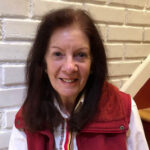Rippling up and down the shoreline, came the laughter of children frolicking near the ocean. Summer had arrived and with it the Fire Island ferries. Soundly docked at the barrier beach, a rush of boisterous mainlanders descended from the boats, most of them tugging little red wagons overloaded with domestic supplies. The vacationers started arriving a few days earlier, eager to open their beach shacks, some of which were tall, multi-decked and party shouting, others cozy quiet ground level cottages. All were forgiving of the bathing suit sand and salt water dripping through them summer long, a sign of Fire Island’s casual life style.
After settling into their weekend rental, a young boy, approaching the age of five, and his mother made their way through a crowd of well-oiled sunbathers, exhausted swimmers and hopeful beach combers. After they dropped their blanket onto the finely ground quartz, the boy took up his little tin pail and shovel and dashed off towards the wet sand to build castles which he embellished with seaweed and small shells. He passed the afternoon not missing his mother but with the fine art of sandcastle engineering and construction fully occupying his mind. Unfortunately, all that had been going so well ended so abruptly. An unexpected force swept across the Atlantic and pushed the now whited capped waves seaboard toward the barrier island. With each crash the breakers took something away with them as they roiled and foamed over the Fire Island shore and back to sea.
To Poseidon, king of the sea went his castles, his pail. The child rushed across the rippling sand and into the foaming water as if he could rescue what was his, but to no avail. His outreached arm dropped to his side and his trembling fingers let go of his little tin shovel. He stood there immobile, as if struck by futility, his inability to retrieve what had been so cruelly ripped from him by the whims of a mighty storm god. He scanned the beach for his mother. Wind struck images of brightly colored beach umbrellas and equally colorful beach blankets blended together like particles in a kaleidoscope changing one world for another in a mere instant. Instead of his sighting his mother he saw a gathering of herring gulls fearlessly facing the wind like grey streaked marble statues. Then as if on some divine cue, one by one they took flight, screeching and crying swooping and soaring over him as if to mark the significance of the unexpected. The young boy ran across the beach and darted around people packing up their belongings. Into the dunes he ran, in search of his mother. His bare feet scampered across the hot sand, kicking up clam shells and jingle shells. They carried him past thorny beach roses and leapt him over a hog nose still sunning itself alongside a length of twisted driftwood. All the while his eyes, covered at times by whisps of his brown wavy hair, searched for his mother, all the while he kept running, running away from the Atlantic’s wide and un-limited horizon that had until then held a quiet peaceful place in his tender heart.
Thomas arrived on time for his appointment. He cautiously followed his soon to be therapist, John, a middle-aged man with a full, friendly face into one of The Center’s therapy rooms. A minimal amount of furniture, a teakwood desk, several slingback chairs and a few potted plants standing on a sunny window shelf created a safe haven for their session. Smiling, John motioned Thomas towards a seat in front of his desk. While Thomas arranged himself, John closed the door and then took his place. After allowing Thomas time to ease into his new surroundings, John gently asked what had brought him to The Center.
Thomas rubbed his knuckles. His hands were large and his knuckles were bruised bright red from this irritation. He made an effort to clear the tightness from his throat. A big muscular guy he found it difficult to admit that an event from so long ago haunted him.
“It’s ok, Thomas,” said John. The calm manner in which his therapist spoke reassured Thomas and some of his tension began to slowly slip away.
“I’m here to help you, Thomas,” said John. “You’ve taken a big step by coming here.”
Thomas struggled with his thoughts for a moment, finding it difficult to speak about his feelings, his anxiety.
“It’s for my job,” he began. “I can’t lose it; I have to go to a beach party; a company party and I don’t know if I can pull it off.”
Thomas told the therapist how what happened at the beach made him fear being without control. “The panic comes on not only when I go to the beach, other things can bring it on, like while I’m driving, I start thinking, what if the driver next to me tries to cut me off.”
John explained that one’s reaction to experience, whether good or challenging experience is a biologically based process based on our perception of the world which means in part how we have been conditioned to live in the world. “Sometimes,” he said, “because ours isn’t a perfect world, things can get distorted. Sometimes our biological response is telling us that we need to find a better way to handle things. With Polyvagal therapy, which we practice at The Center, you’ll learn how to handle challenges, even the most difficult ones, in a calm and centered way.”
Thomas ran his fingers loosely through his wavy brown hair and then sat with his hands settled loosely on his thighs. He listened carefully while John continued.
“What I’m saying is that we can help you learn to regulate your nervous system by using techniques such as breathwork. Breathing slow down-regulates the nervous system so you can think clearer. Another technique is active listening, with this you learn to listen to your body, when your heart is racing it’s telling you to do something to calm down, like take a walk, or do some breath work. When you learn how to manage your body’s stress response you can start exploring what went wrong that day, the role your mother played by her disappearance at a crucial moment. You’ll start to gain some understanding, not only of her challenges, and how they might have affected you, but also how life in general can present emotional challenges and how to deal with them. With this understanding you can safely release the trauma you suffered and prevent new psychological damage from occurring.
Before the session ended John showed Thomas one of several ways to breathe through a panic attack: a normal breath in and a slow exhale. He also handed him a pamphlet which further explained Polyvagal Theory and therapy. He emphasized that mindfulness was one of the most important things he needed in order self-regulate. You have to be aware of both your emotional and physical needs, and work with intention to satisfy them.
Thomas got up from his chair. He held out his hand and thanked his therapist. He didn’t have to say anything more, the light in his eyes spoke for him and conveyed his feeling of hope and with that soon any raging surge of his own inner tide would be under self-control.
 Diane Lundegaard is a Polyvagal Enthusiast. The Polyvagal Theory was created by Dr. Stephen Porges. Learn more through the Polyvagal Institute or on the Stuck Not Broken podcast from Justin Sunseri.
Diane Lundegaard is a Polyvagal Enthusiast. The Polyvagal Theory was created by Dr. Stephen Porges. Learn more through the Polyvagal Institute or on the Stuck Not Broken podcast from Justin Sunseri.




















